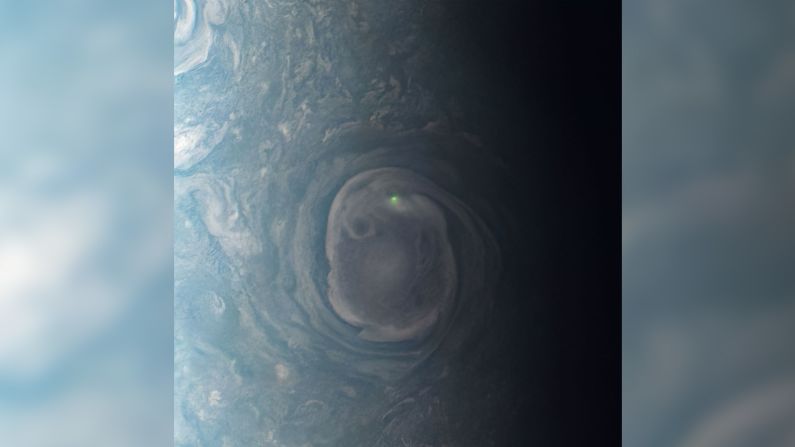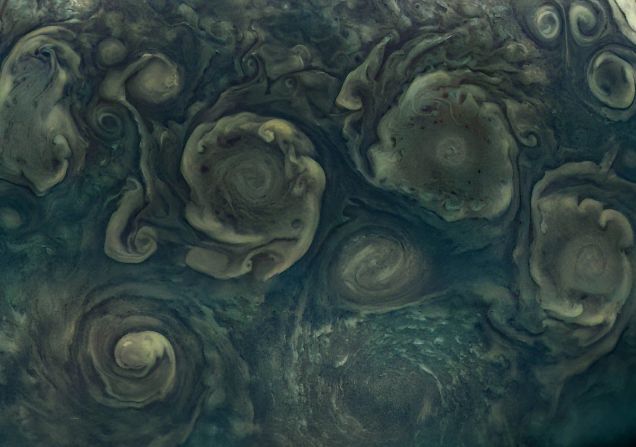When NASA’s Galileo mission visited Jupiter in the 1990s and began its descent,the spacecraft’s data was expected to solve a puzzle for scientists. They wanted to know how much water was present in Jupiter’s atmosphere.
But just as things were getting good, the probe stopped transmitting 57 minutes and 75 miles into its descent, crushed by the pressure of Jupiter’s atmosphere. Intriguingly, Galileo detected that the amount of water in the atmosphere increased as it dove down. However, scientists were disappointed when the data reflected ten times less water than anticipated.
Enter NASA’s Juno mission, which launched in 2011 and began conducting scientific flybys of the planet in 2016. Scientists have used data from the first eight flybys to determine the amount of water in Jupiter’s atmosphere at the equator, according to a new study.
“The Juno mission was in part motivated by the need to determine the water abundance at multiple locations across the planet,” the authors wrote in the study, which published recently in the journal Nature Astronomy.
To be clear, water doesn’t necessarily mean liquid water, but its components of hydrogen and oxygen. Understanding the amount of water on Jupiter can provide more information about the gas giant’s past. The largest planet in our solar system was also likely the first to form after the sun. The theory of planet formation suggests that Jupiter received the bulk of the gas and dust leftover from our star.
Scientists want to know how much water was included in this process. And Jupiter reflects processes that include water and moisture, like its weather patterns and even its lightning, as witnessed by the Voyager probe in 1979.
Based on thermodynamic calculations, scientists believe that there are three distinct cloud layers in Jupiter’s thick atmosphere. They include ammonia ice clouds, ammonium hydrosulfide ice clouds and clouds made up of water-based droplets and ice, according to the study.
The 1995 Galileo probe data was dropped into a “hotspot” in the boundary between the equator and the north equatorial belt. Data collected during Juno’s flybys showed that water makes up 0.25% of molecules in Jupiter’s atmosphere at its equator.
Juno is also equipped with the Microwave Radiometer. Rather than descending through Jupiter’s atmosphere, Juno uses this instrument to study it from above through six antennae gathering temperature data at various depths, according to NASA. It relies on microwave technology to detect water absorption at different wavelengths.
Juno was also able to surpass the depth of Galileo’s descent, gathering data farther down in the atmosphere at 93 miles.
“We found the water in the equator to be greater than what the Galileo probe measured,” said Cheng Li, a Juno scientist at the University of California, Berkeley. “Because the equatorial region is very unique at Jupiter, we need to compare these results with how much water is in other regions.”
The study authors warn that these findings may not be indicative of water abundance across Jupiter.
If it is globally reflective, it may suggest that the planetary building blocks that formed Jupiter were unlikely to have been water-rich clathrate hydrates, or crystalline water-based solids like ice.
“Just when we think we have things figured out, Jupiter reminds us how much we still have to learn,” said Scott Bolton, Juno principal investigator at the Southwest Research Institute in San Antonio. “Juno’s surprise discovery that the atmosphere was not well-mixed even well below the cloud tops is a puzzle that we are still trying to figure out. No one would have guessed that water might be so variable across the planet.”
In the future, the team hopes to learn how the water content may vary across regions and how the poles, dotted with cyclones, could reflect more insight.
“Every science flyby is an event of discovery,” said Bolton. “With Jupiter there is always something new. Juno has taught us an important lesson: We need to get up close and personal to a planet to test our theories.”







































